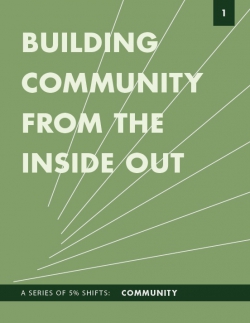Building Community from the Inside Out: A Series of 5% Shifts
About this Series:
The Building Movement Project develops tools that help organizations align their social change principles with their social service practices. Our research and experience shows that relatively small shifts in service provision can cause ripple effects; raising up constituent voice, fostering community cohesion and increasing engagement in advocacy efforts. This series highlights “5% shifts”—as we are calling them—that don’t rely on organizations completely changing course and reinventing themselves. We lift up shifts that are both simple and achievable, to inspire service providers to adapt what works. These reports are structured to include both conceptual framing based on research and literature in the sector, as well as case studies of on-the-ground experiments initiated by organizations. They also include discussion materials and other resources to help staff and leaders reflect on the case examples and apply the lessons to their own organizations. We hope that organizations will take what is useful, build on their strengths, and exercise judgment and wisdom in tailoring these examples to make “5% shifts” that fit their specific community and organizational contexts. We invite organizations to spread these lessons and learning throughout the nonprofit sector, and to reach out to BMP to share experiences or to request additional resources or coaching. Feel free to email us at info@buildingmovement.org.
About this Report:
This report includes two case studies of community building efforts by nonprofit organizations in Detroit and New York City. St. Matthew’s & St. Joseph’s Episcopal Church’s hot breakfast program in Detroit offers a model of a small shift in engagement with community members seeking healthy meals in the midst of an urban food desert. Their decision to shift from using a soup line mode of serving individuals to serving groups with shared ‘family-style’ meals leveraged the power of ritual around meals, which are both nostalgic and deeply affirming, to transform dynamics between clients and volunteers. But more importantly the shared meal time became a way to model the kind of community the church envisions for Detroit—one of mutual aid, sharing and abundance. The other case—Queens Community House—provides an example of community building among staff. The organization took on the challenge of fostering relationships among staff; not to boost morale and retention, but to live its values and principles in all parts of the organization.
The two cases profiled here focus on staff and clients, but organizations around the country are innovating to build a sense of community with volunteers and boards as well. Organizations who find inspiration in these examples and new insights from the tools and discussion questions are encouraged to find and develop their own practices. There is surely something within every organization that can be built upon to create that familiar sense of belonging that makes the notion of community so appealing. It just takes a small shift for organizations to tap into the feeling of community, and the benefits will reverberate beyond an organization’s walls.

